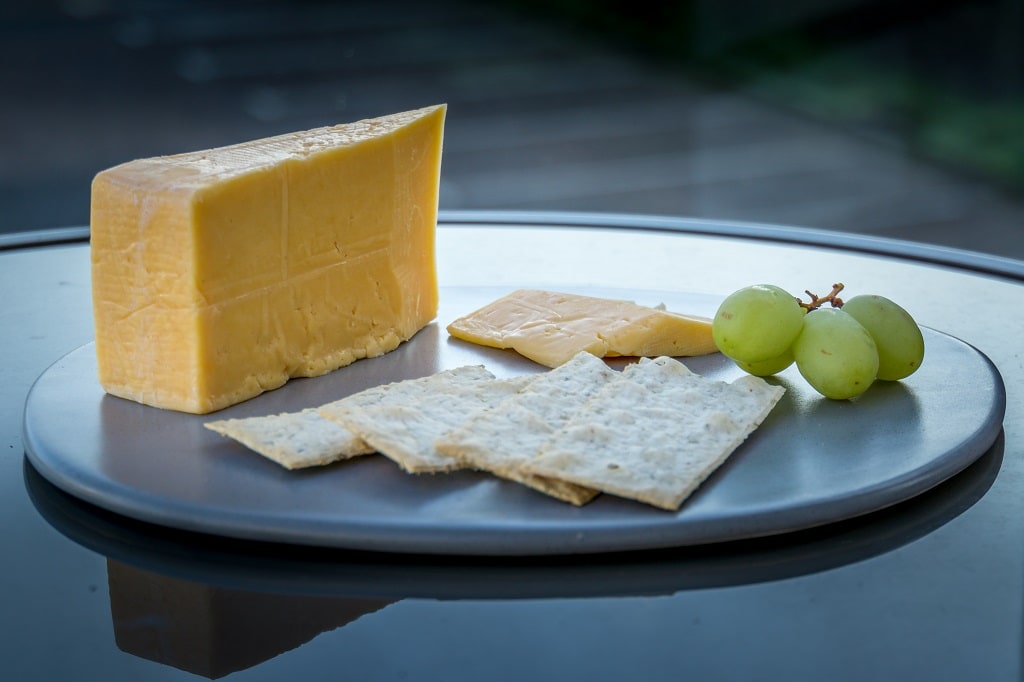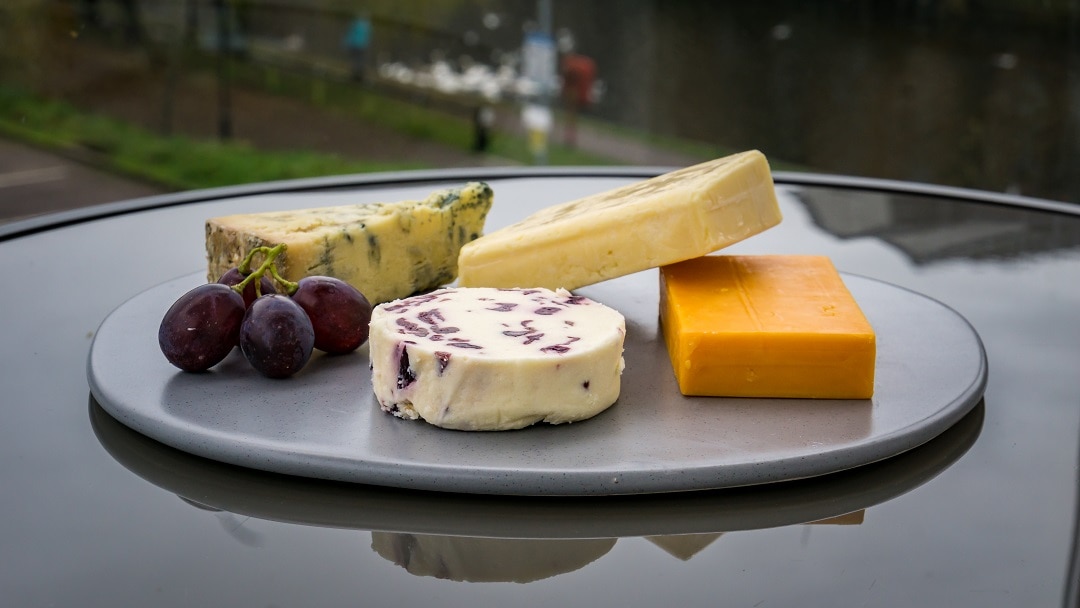Britain is probably not the first place that comes to mind when you think of delicious cheese. Since I have moved to England, I have come to respect and appreciate the cheeses that are made here.
If you are a cheese-lover, like me, you will definitely want to make a point of trying some of the cheeses when you visit the UK. The problem is there are so many different varieties out there. That’s why I have compiled this list of the best British cheeses.
Contents
The 9 Best British Cheeses
Today, Britain produces over 750 varieties of cheese! Each year, more than £2 million worth is sold, with half of that being cheddar. You will want to try as many different kinds as possible.
I could eat British cheeses for every meal, but that’s not the best idea healthwise. For me, it’s more a treat that I love to enjoy with some wine.
Keep in mind quality does vary among different makers of each type of cheese. I would encourage you to support the smaller local cheesemakers.
#1 Blue Stilton

Stilton is the most popular British version of blue cheese. It is the only British cheese to have a Certification Trade Mark and an EU Protected Name. This cheese can only be produced in the three counties of Derbyshire, Nottinghamshire, and Leicestershire. It is made from locally produced cow’s pasteurized milk in a cylindrical shape and is allowed to form its own crust which is edible.
Blue cheeses are easily identifiable by the blue veins in the cheese. Other famous blue cheeses include Danish Blue, Gorgonzola, and Roquefort. With Stilton, you will notice that blue veins radiate out from the center in a very distinctive pattern. The flavor is not quite as intense as a Roquefort but I think it is more buttery and less crumbly. It may have a stronger flavor than the Danish Blue but it’s not quite as creamy.
Traditionally, this cheese has been paired with sherry and port wine. We also like to have it with red wine. It’s delightful after dinner with crackers. As the Blue Stilton matures, the flavor grows. Some may find the flavor too strong on its own. Russell prefers it with a glass of port after it has had more time to mature.
You could also try a White Stilton, which does not have the blue veins. It’s also quite crumbly. Personally, while we enjoyed the White Stilton, the Blue is our preferred choice.
#2 Wensleydale

Wensleydale is a creamy, crumbly white cheese that is available in many flavors. Some of the most popular varieties include cranberry, apricot, and roasted garlic. During the Christmas season, there are many options available at the Christmas Markets and you can try them before you buy,
It gets its name because it was originally produced in Wensleydale, in North Yorkshire, England. The cheese was first made by French Cistercian monks from the Roquefort region, who had settled in Wensleydale. Traditionally sheep’s milk was used to make Wensleydale, but now it is produced mainly from pasteurized cow’s milk with some sheep’s milk added for flavor.
Wensleydale goes well with fruit cake (or Christmas cake) and apple. It also tastes delicious with hot desserts like fruit pies and crumbles. I think my favorite way to enjoy Wensleydale is with some crackers and a glass of white wine.
#3 Cheddar

Growing up in the US, I thought that Cheddar was invented in Wisconsin, but no! It originally comes from the village of Cheddar which is in the county of Somerset in England. The Cheddar Gorge provided the ideal humidity and temperature for maturing the cheese. Traditionally, Cheddar cheese had to be made within 30 miles of the Wells Cathedral, but now it is made around the world.
You may be wondering if there is a difference between the cheddar in England and the cheddar in America? Yes, there are a few:
- There is no such thing as orange cheddar in Britain. All the cheddar here is white.
- In the UK, instead of calling cheddar cheese sharp, they use the term mature. If you are looking for an extra sharp cheddar in England, look for a package that says extra mature.
The flavor of cheddar varies depending on how long it has been aging. The more mature cheddars have a stronger flavor, while younger cheddars may be better for melting. Even the mature cheddars are versatile and can be eaten alone or used in many recipes. If you are having cheddar as a snack it goes well with fruit. For wine pairing, it’s excellent with a Cabernet Sauvignon or Chardonnay.
#4 Lancashire

Lancashire cheese is similar to Wensleydale cheese. It is a cow’s milk cheese that is just as creamy, but may not be quite as crumbly. This cheese gets its name from the county in the northwest of England where it is made.
There are actually three types of Lancashire cheese: Young Creamy Lancashire and Mature Tasty Lancashire which are still made using the traditional method, and then what is called Crumbly Lancashire which is mass produced. The packages of Lancashire cheese that I have had have not specified the variety so I assume it is the crumbly one.
I love the creaminess of this cheese. It’s decadent with crackers and makes an excellent dessert cheese. The flavor is mild so it would pair nicely with most foods and beverages.
#5 Red Leicester

Originally, Red Leicester was called Leicestershire Cheese after the English county where it is made. Most Leicestershire cheese was traded in the cheese market that was established in 1759 in the county town of Leicester, so then it became to be known as Leicester Cheese. Eventually it became to be called Red Leicester to distinguish it from “White Leicester,” which was made without any coloring due to rationing during World War II.
It was originally coloured with carrot or beetroot juice. Since the 18th century, it has been coloured orange by adding annatto extract during manufacture. It was dyed because the rich orange hue signified a high quality cheese like Double Gloucester that was made from rich creamy milk.
Red Leicester is a versatile cheese that is sometimes used as a cheddar replacement. It has a slightly nutty taste. While it’s a firm cheese, it melts well as it has a creamy texture. It reminds me a bit of colby cheese in the USA.
Note: Leicester is not pronounced like it is spelled, in the UK, they say Lester. I know it doesn’t make sense but it is what it is.
#6 Double Gloucester

Double Gloucester is a semi-hard cheese traditionally made from the milk of Gloucester cows. Their milk is ideal for cheese making because it is high in protein and butterfat. In the 1970s, the Gloucester cattle came close to extinction, so now Double Gloucester can be made from other types of milk.
The cheese has a distinctive yellowish orange color. Originally it came from the Lady’s Bedstraw flower, but now it is more popular to use annatto.
It also has a thick blue-grey rind for two reasons. First, to be able to withstand the annual cheese-rolling ceremonies, when Double Gloucester would be rolled down the hills to mark grazing rights. Now cheese rolling is a dangerous race with the winner getting cheese as the prize. Secondly, tradition dictated that cheese merchants jump on their Double Gloucester with both feet to make sure the rind didn’t crack. This confirmed that the cheese had matured enough to be shipped.
There is also a Single Gloucester Cheese, but it’s not common to find it in a grocery store. It is still required to be made in Gloucester from the milk of Gloucester Cheese. Single Gloucester is more crumbly, lighter in texture, and lower in fat. It’s also not aged as long as Double Gloucester.
No one is sure where the Double and Single names came from, but there are different theories:
- Double Gloucester is usually shaped into taller rounds than Single Gloucester, in some cases twice the height.
- You have to skim the cream from the milk twice to make the double variety.
Double Gloucester cheese has a buttery taste. You can also find it mixed with spring onions or other flavors like Wensleydale. It’s a tasty cheese to snack on and pairs nicely with light-bodied red wines like a Pinot Noir. It also melts nicely so will work in many recipes.
Note: Gloucester is also not pronounced like it is spelled. Instead you should pronounce it GLAH-sta. Getting the correct vowel sound is not easy for those of us from the USA.
#7 Cheshire Cheese

Cheshire Cheese is one of the oldest recorded named cheeses in British history first mentioned in 1580 by Thomas Muffet in his book Health’s Improvement. While the name comes from the English county of Cheshire where it was first made, now it is also produced in four neighboring counties (Denbighshire and Flintshire in Wales and Shropshire and Staffordshire in England.)
It’s a dense, semi-hard cheese with a bit of a salty taste. I thought it tasted a bit like a mild Parmasean. Some versions can be crumbly, but the one we tried wasn’t. While this cheese comes in three varieties, red, white and blue, the white is the most common.
If you want to learn more about Cheshire cheese there is an exhibition of the cheese’s history at the Nantwich Museum.
#8 Shropshire Blue

Shropshire Blue is a relatively new British cheese as it has only been around about 50 years. It was first made in the 1970s at the Castle Stuart dairy in Inverness, Scotland by a cheesemaker who was experienced in making Stilton cheese. They originally called this cheese Inverness-shire Blue or Blue Stuart, but changed the name to Shropshire Blue to help increase its popularity.
After the Castle Stuart dairy shut down in 1980, two cheesemakers from Cheshire continued to make the cheese for a bit. Now it is made in Leicestershire, Nottinghamshire, and Shropshire.
It’s a blue cheese made from pasteurised cows’ milk that uses vegetable rennet to start the cheese making process. Similar to Red Leicester, the orange color comes from the addition of annatto.
This cheese is comparable to Stilton because it is made in a similar way. While the flavor reminds me of Stilton, this cheese is much creamier. It pairs perfectly with a full-bodied red wine or port.
Note: The story of where Shropshire Blue originated is disputed. The Shropshire-based company, Westry Roberts, claims the cheese did originate in Shropshire.
#9 Stinking Bishop
A list of the top British cheese would not be complete without mentioning Stinking Bishop. Even though I have heard lots of good things about this cheese, we have not tried it. My husband doesn’t want it in the house.
It has a distinctive odor (i.e. tactful way of saying it stinks!) that comes from washing the cheese in an alcoholic beverage (perry) made from the local Stinking Bishop pear every four weeks while it matures. It is an artisanal, handmade cheese and you won’t find it in any supermarket even here. It’s available at artisan food stores as well as in some high end stores like Harrods and Selfridges.
If you saw the 2005 Wallace & Gromit movie, The Curse of the Were-Rabbit,you may remember that Gromit used Stinking Bishop cheese to revive Wallace when he seemed to be dead. After that film, the demand for the cheese skyrocketed.
UPDATE: I finally tried Stinking Bishop cheese at Benedicts Restaurant in Norwich and it was delicious. The smell was not as strong as I expected but our server told us it had been sitting out for a while.
My Favorite British Cheese
It is tough to choose one favorite when it comes to British cheeses. I guess it depends on the situation and maybe even my mood.
During my process for writing this blog, I re-tasted each one with crackers (and sometimes wine) and I have to say I loved each one. The ones that stood out to me were the Lancashire, Shropshire Blue, and Red Leicester though. For Russell, his favorite is still a nice mature Stilton with a glass of good quality port.
Your favorite is going to depend on the type of cheese that you enjoy. If you like a blue cheese, try either the Stilton or Shropshire Blue. If you want a creamy more mild cheese, try the Lancashire Cheese. Cheddar or Red Leceister are the most versatile.
Have you tried any of these British cheeses? Which ones are your favorites?
-Anisa
Last Updated on April 18, 2022


